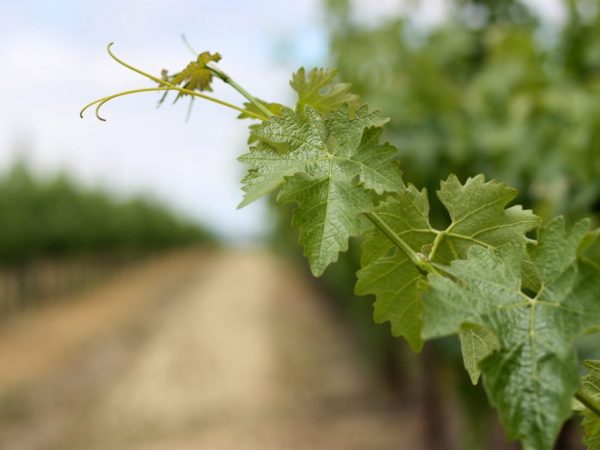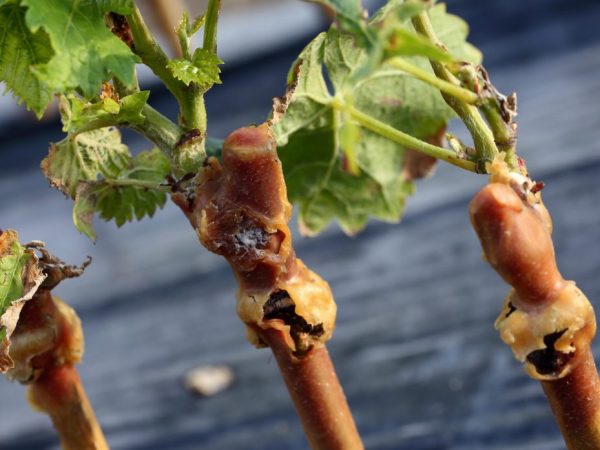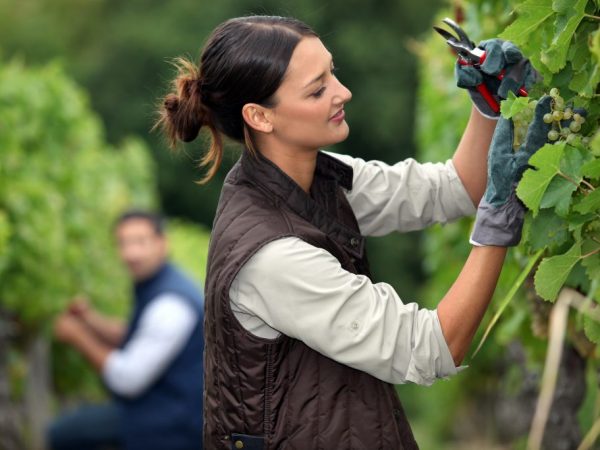Secrets of caring for grapes in summer
The grapes require special care in the summer. Timely watering, feeding and pruning are important for him. Each summer month has its own set of rules and recommendations for care.

Secrets of caring for grapes in summer
Care features
The summer period is an important stage in the development of grapes, therefore, special attention is paid to it. If you take proper care of the grapes in summer, the bush will easily survive even a frosty winter.
To care for grapes in the summer, spend:
- Topping. It allows the plant to develop better.
- Coinage. It is used if the plant has stopped growing.
- Stealing. It improves nutrition.
- Thinning. It allows the plant to breathe better.
June
The most important period in vineyard care is June. At this time, the bush is forming and blooming, and this is the basis for a good yield.
The first step is to pinch the shoots so that the flowers are easier to pollinate. This occurs before the flowering period (up to 10 cm of the growth point).
Pruning
One table variety vine should have one bunch, for a regular vine - up to three. Many varieties bear fruit in four bunches, but this is physically difficult for the escape, as a result the plant is injured. The rule is mandatory for varieties with large berries and bunches.
The crop is preserved if pruning occurs before flowering. Pruning late will reduce the number of fruits.
Gardeners remove dry, unhealthy vines, leaving only a fraction of them to retain nutrients. Pruning is especially beneficial in summer because the grapes are exposed to sunlight. The disadvantage of weak shoots is that they rarely bear fruit and only deplete the plant.
For proper pruning, consider the structure of the plant:
| Vine | This part of the bush is left to winter. |
| Sleeves | This part is called perennial wood. This is a vine that is over 2 years old. |
| Peephole | Consists of a main kidney and several additional ones. |
| Fruit arrow | This is an annual part of the bush, in ordinary varieties, consisting of 6 eyes, in large ones - from up to 20. Formed on biennial plants. |
| Replacement knot | This vine is 1 year old. It is cut off for a couple of eyes, it is located under the fruit arrow and replaces it in the future. |
| Inflorescences | Formed from 2 to 6 knots (they are counted from the base of the shoot), from 4 to 6 knots, and for an adult - 15 knots each. |
| Coppice shoots | They consist of dormant buds, cut off immediately, since they slow down the growth of shoots. |
| Fruit arrows | Shoots that form on vines after wintering. The harvest is formed on them. |
Pros of pruning:
- more harvest;
- larger and better quality fruits;
- improving taste;
- faster ripening process;
- fewer diseases;
- easier to care for the plant;
- better ventilation of the culture;
- more sunlight;
- better plant nutrition.
Graft

Vaccination is carried out in early summer
In the first months of summer, summer residents carry out shoot grafting (the cuttings are grafted onto the shoot).Cuttings are cut from a one-year-old shrub of the required variety, the ends are sharpened and inserted into an incision in the rootstock.
Additionally, perform the necessary actions before vaccination:
- shanks (cuttings) are kept in water;
- the material is prepared in the fall, cut and sharpened (no more than 3 cm);
- the eyes of the scion and stock during grafting are directed in opposite directions;
- after grafting, create greenhouse conditions.
Top dressing
The grapes are fertilized monthly so that they bear fruit better and give a high-quality harvest. The plant is fed no earlier than a couple of weeks before flowering. Use:
- nitrogen substances;
- potassium salt;
- superphosphate.
During the flowering period, the plant is not fertilized. After fertilizing the soil, the foliar system is fertilized. Thanks to these procedures, the vineyard becomes healthier, bears fruit more actively, and is well pollinated. To do this, use:
- "Gumisol";
- potassium humate;
- boric acid;
- potassium chloride;
- zinc sulfate.
When the ovaries are formed and formed, the grapes are fertilized for the third time, using only phosphorus-potassium preparations. 50 g of fertilizers are diluted in 15 liters of water (this is a dose per bush).
There are green dressings. To fertilize the bush additionally, planting peas between the rows is used. Legumes enrich the vineyard with nutrients.
Spraying
If you systematically spray the vineyard in the summer, the plant will be protected from parasites and diseases. To do this, use:
- 10 liters of water;
- 0.5 tbsp. l. boric acid;
- manganese (on the tip of a knife);
- 1 tbsp. l. potassium humate;
- 20 g of the drug "Kemira-Lux";
- 1 tsp the drug "Novosil";
- 65 g of soda;
- additionally, fungicides for diseases are introduced.
The shrub is regularly examined carefully. This makes it possible to detect diseases, fungi and parasites in time. If mildew is started on the grapes, use the drug "Ridomil Gold", if the spider mite - "Fufanon", if oidium - "Topaz". Fruiting vines are sprayed with a solution of water with manganese and soda.
Stepson and garter

Grasshopping is performed with a strong plant density
Grasshopping is carried out to protect the plant from unnecessary shoots that grow from the main leaf. These vines take up nutrients, interfere with airing and sunlight on the plant. Work is carried out only if new shoots create a strong density. Otherwise, new shoots contribute to better nutrition for the whole plant, and the fruits become sweeter.
The garter is carried out so that the grapes breathe better, feed on sunlight, and also form well. For the procedure, materials are used that can rot in the soil, while not polluting the vineyard.
Landing
The planting period of seedlings falls on the end of May-June. For this, the planting material is hardened in the shade for 4-6 days, after which the cuttings are moved to a sunny place for a period of up to 10 days. The landing site should be no more than 30 cm deep. The planting pit is prepared with additional fertilizers.
After planting, the seedlings are tied to a tie or peg for support. In the first year, all additional shoots are removed.
July
July is one of the most important periods in the development of the vineyard. This is the stage at which the berries ripen, so the plant needs food and watering. Regular inspection of the culture helps to detect diseases and parasites in time.
Watering
With proper watering, the plant bears fruit with large, tasty and high-quality berries. Grapes calmly perceive dry air, but do not take root well in dry soil.
Watering is carried out using warm rain or well water. Watering with chilled tap water is prohibited.
Before irrigation of grapes, the liquid is defended for two days. Newly planted shrubs are watered with hot water.
The work is performed in several ways:
- Surface.This is the most common method of irrigation, with the help of which the liquid enters the plant through the ditches that are along the rows, fertilizers are often added for better growth and yield, but this is done only before the fruits ripen, potassium or phosphorus is added.
- Subsurface.
- With the help of sprinkling.
- Aerosol.
- On the principle of drip irrigation.
Top dressing
In early July, top dressing is used along with watering. The composition of this fertilizer includes:
- 2 g of potassium sulfate;
- 10 liters of water;
- 5 g of a complex of nutrients;
- 2 liters of fermented herb solution.
The recipe is used for watering 3 sq. m of territory. The nutrient is used for newly planted plants, as well as for dry soil.
The watering liquid should be warm. Needles are often used for mulching, then the fruits are sweeter and less likely to suffer from fungal ailments.
Foliar dressing is performed using one of the following preparations:
- Novofert;
- Plantafol;
- "Aquarin".
Pruning and garter

Pruning improves light access to berries
In July, 2 main operations are performed: removal of stepsons and tying vines. The stepson is a lateral shoot that emerges from the inside of the leaf. It is pruned so that more sunlight falls on the bush. This makes the fruit sweeter.
When the ripening period comes, all the leaves near the bunches are cut off. This is done so that there is no shadow on the berries. From this, the color becomes richer and helps to speed up the process of fruit development.
The offshoots of the second and next level are cut off, but not completely. Only the top is cut off (2 cm from the leaf). This is done because many stepchildren are released during the July period.
August
In August, most varieties begin their ripening period. The root system of plants begins to actively produce sugar and send it to the berries, therefore providing the shrub with nutrients enriches the taste of the fruit.
Watering and feeding
When ripe, grapes are not watered abundantly in August. If the plant dries up and the climate is dry, moderate watering is done along with nutrients: phosphorus and potassium.
Wood (ash) contains potassium and a little phosphorus, therefore it can replace them as a fertilizer that is well absorbed. Thanks to him, the berries become denser and stop cracking.
Pruning
Pruning grapes in August takes place in several stages:
- pinching;
- trimming leaves;
- trimming unnecessary bunches.
In the third month of summer, young vines begin to stiffen. The shoots develop less actively, and the green shell of the shoots becomes brown. During this period, the lower part of the bush is actively developing.
At this stage, chasing is carried out - pruning of 8 grape leaves at the tops, which create the density of the shrub. Such work is carried out at 15-30 cm, depending on how vigorous the plant is.
Minting is done with a special pruner. No more than 16 leaves are left on one shoot so that the bunches are well nourished. If the summer period is dry, minting is not necessary. Fragment of all dry parts is made immediately, especially if there are signs of fungus or other diseases.
Landing
Young grape cuttings are planted in August so that the bush has time to take root before the first frost. If the planting material is a vine with a well developed root, it is planted in early September. Planting dates depend on climatic conditions.
Residents of the Northern regions plant planting material no later than August, and the Middle Lane - no later than October.
Graft
Grafting (budding) of grapes in August takes place under special temperature conditions (air temperature - at least 15 ° С, and soil - from 10 ° С). Graft last year's young woody vines to mature plants.
Near the vine, to which the sprout is grafted, dig a hole up to 20 cm deep. If the bole is thick, up to 4 shanks are grafted. Each branch must have at least 2 eyes. Gardeners tie the processing site with a special twine.Each sprout must be under a layer of earth.
Conclusion
In summer, grapes need special care and attention. In order for the berries to grow tasty and high-quality, a number of special operations are carried out every summer month.
All treatments with drugs to protect against pests and diseases are performed before ripening. So that the fruits are not sour, the culture is provided with good nutrition. The plant is pruned regularly to keep it well ventilated and get enough sunlight.


